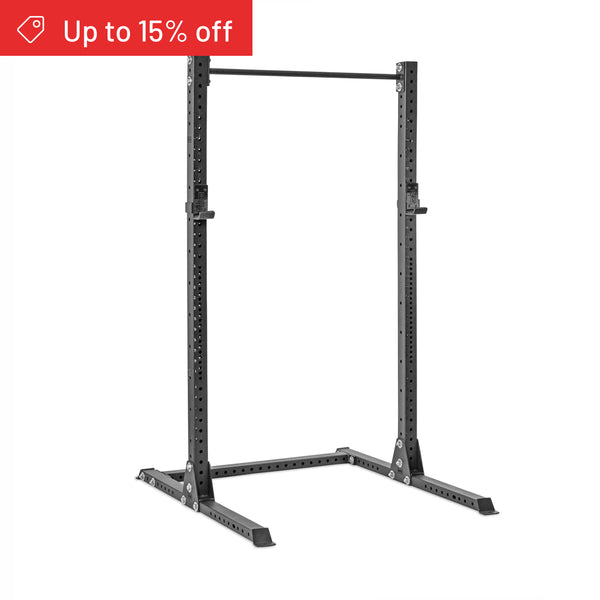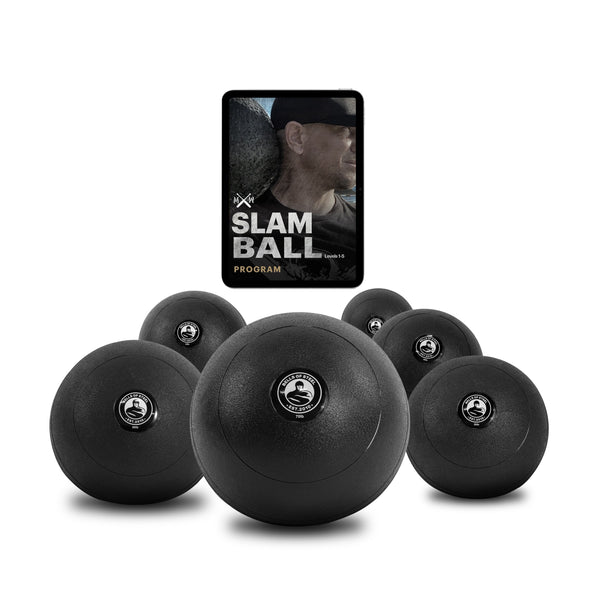So, you've decided to transform your home into a muscle-packed haven, and you're all set to conquer the world of weightlifting.
But wait, before you start pumping iron, let's address the elephant in the room—squat stands. Are they safe for your home gym setup?
We're here to break it down for you with some information on staying safe and choosing the right squat stand. Let's be real for a moment. Squat stands aren't the most imposing pieces of equipment in the weightlifting universe. When you look at those thin, vertical bars, it's only natural to wonder if they're up to the Herculean task of holding your heavy weights.
Here are a few main concerns we hear about:
Concern #1: Tipping Over
One of the biggest concerns is the possibility of these stands tipping over. After all, you don't want your home gym to turn into a real-life game of Jenga, where the consequences are more than just a few wooden blocks falling.
The solution: Bolts and beef. Look for a beefy squat stand that won’t rattle and shake every time you unrack, and bolt that sucker down.
Concern #2: Lack of Safety Features
Compared to their beefier cousin, the power rack, squat stands seem a bit barebones. No safety pins, no straps—just two poles and a dream (and a barbell).
The solution: Spotter arms. And beef again. Now that we've laid out the concerns, let's talk about how to make squat stands safer in your home gym.
Quality Matters
First things first, invest in high-quality squat stands. Look for sturdy materials, a solid base, and a reputable manufacturer. You wouldn't buy a parachute from a discount store, right? Same principle applies here.
Crossmember
Look for a squat stand that’s connected with a crossmember for extra stability. Bonus if there’s a pull-up bar too. 😉
Weight Distribution
Keep your weights evenly distributed on both sides of the stand. This not only prevents tipping but also helps maintain stability during your lifts. If you're loading up one side like a lopsided pizza, you're asking for trouble.
Spotter Arms
Consider getting spotter arms to catch the barbell if you fail a lift. They're like the guardian angels of your home gym, there when you need them most.
Flooring
Don't forget about your gym's flooring. A solid, level surface can make a world of difference in stability. And hey, it's also easier on your feet than those cold, hard tiles. Ah, the age-old debate: squat stands vs. power racks. Can one truly replace the other?
Let's break it down.
The Squat Stand Pros
Squat stands offer several advantages over power racks, especially for home gym owners:
- Space-Saving: They take up less room, making them ideal for smaller spaces.
- Cost-Effective: Squat stands are usually more budget-friendly.
- Versatility: You can use them for a variety of exercises, not just squats.
The Power Rack Pros
Power racks have their own set of perks, and they're often favored by serious lifters:
- Peace of Mind: Four sturdy uprights and safety straps often help lifters feel safer while pushing big weights.
- Attachment Options: You can add various accessories like pull-up bars, dip stations, and cable attachments. While you can do this with the Hydra Squat Stand, more uprights means more places to put your accessories.
1. Do I need a spotter with squat stands?
It's not mandatory, but having a spotter or spotter arms is highly recommended, especially when lifting heavy. Learning how to safely bail is also important.
2. Can squat stands hold as much weight as power racks?
Quality squat stands can handle a significant amount of weight, but power racks are generally more robust. When bolted down, the Hydra Squat Stand has a 1,000lb capacity (the same as the Hydra power racks!)
3. How do I prevent my squat stand from tipping over?
Ensure your squat stand is on a level surface, evenly distribute the weights, and consider bolting them down.So, are squat stands safe for your home gym? The answer is a resounding "yes," but with a few caveats.
Invest in quality, practice proper weight distribution, and consider safety features like spotter arms. Squat stands can be a fantastic addition to your home gym, offering versatility and space-saving benefits, but they may not replace a power rack entirely if safety is your top concern.
In the end, it's all about finding the right fit for your fitness journey. Whether you're Team Squat Stands or Team Power Rack, the most important thing is to keep lifting, stay safe, and have fun with it.



